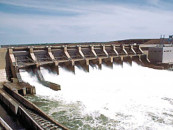IRSA orders closure again

IRSA orders closure again
Irsa’s spokesperson said the authority had taken the decision on the request of the Water and Power Development Authority (Wapda) which said that siltation was increasing in the country’s reservoirs after floods triggered by monsoon rains. Silt is granular material of a grain size between sand and clay derived from soil or rock. Silt may occur as a soil or as suspended sediment in a surface water body.
“The (CJ link) canal has been closed due to technical reasons and it has nothing to do with politics,” said the Irsa spokesperson, Khalid Rana. He added that the canal might be opened after three or four days.
Irsa had opened the canal on July 15 with a direction to provide 15,000 cusecs of additional water to Punjab, increasing its share to 135,000 cusecs. Later, the body succumbed to political pressure and opened the canal after receiving directions from the government.
However, experts don’t agree with the claim that the canal has been closed because of siltation.
“This time around closing the (CJ link) canal for a few days is in Punjab’s interest,” Fazalullah Qureshi, an energy expert, told The Express Tribune. “Because of heavy floods, inflow in the rivers was more than required. And by deciding in favour of closing the canal, Punjab saved its 15,000 cusecs of water quota,” he added.
Qureshi said the Trimu Barrage was filled to its capacity because of better inflow in the Chenab River. The barrage, constructed in 1939, has a maximum design discharge capacity of 645,000 cusecs. When the barrage is filled Punjab does not need water from the Chashma-Jhelum Link Canal, which feeds the Jhelum River downstream of the Rasul Barrage.
The Irsa spokesperson said the closure of the canal will not affect Punjab’s share, as the province has already requested to decease its share from 140,000 cusecs to 100,000 cusecs. Irsa also decided to cut Sindh’s share at the province’s request from 240,000 cusecs to 220,000 cusecs.
He said Balochistan had also requested to reduce its water share from 13,000 cusecs to 6,000 cusecs while Khyber Pakthunkhwa’s water share was intact at 3,000 cusecs.
The authorities also decided to increase storage in Tarbella Dam by another 30,000 cusecs. On Tuesday, inflow in the reservoir was recorded at 220,000 cusecs and outflow at 190,000 cusecs. The dam is filled up to the level of 1,508 feet, two feet below a level after which the authorities may not be able to store more than 25,000 cusecs water or one foot per day. The maximum storage capacity of Tarbella Dam is 1,550 feet.
Published in The Express Tribune, July 28th, 2010.



















COMMENTS
Comments are moderated and generally will be posted if they are on-topic and not abusive.
For more information, please see our Comments FAQ